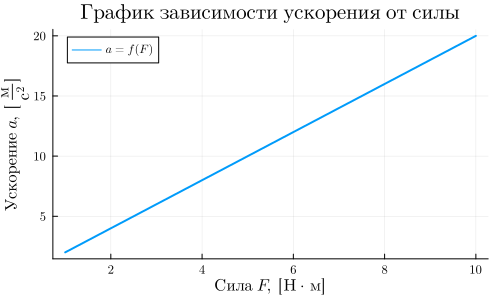Designing Engee scripts using LaTeX
This example shows a set of commands in the document markup language. , which allow convenient and presentable formatting of mathematical expressions, text and graphs in user-generated interactive scripts Engee.
When designing scripts in Engee, keep in mind that the display of mathematical symbols in expressions embedded in a string, for example: it may differ from the display of characters omitted from the string: $$\int\frac{1}{\sigma {\sqrt{2\pi}}},e{-{(x-\mu)/2\sigma^{2}}};dx$$
The list of commands shown in the example it is not exhaustive.
1. Signs and symbols
1.1. Number systems
Natural
Natural with zero
Simple ones
Whole ones
Rational
Algebraic
,
Irrational
The real ones
Comprehensive
Quaternions
Octonions (Cayley numbers)
Sedenions
1.2. The Greek alphabet
1.3. Ellipsis and matrices
Ellipsis at the bottom
Ellipsis in the center
Vertical ellipsis
Diagonal ellipsis
Matrices
1.4. Brackets, limiters
Horizontal curly braces
Parentheses
Automatic scaling of brackets
Curly braces
Square brackets
Angle brackets
Straight brackets
Double straight brackets
1.5. Indexes and accents
Indexes
Indexes and degrees
The usual accents
Wide accents
1.6. Other
Hebrew Symbols
Reduced Planck's constant (Dirac's constant)
Some of the more specific signs not shown in this example can be found in the documentation Engee.
2. Arithmetic and elementary algebra
Not equal to
Approximate equality
The identity
Proportionality
Plus or minus
A minus is a plus
The amount
The dot product
Vector and matrix product
Tensor product
Piecemeal work
Composition
Fractions
Obelus
The square root
The root of the nth degree
Exponentiation
Infinity
The actual part
The imaginary part
3. Set theory
The empty set
,
Belongs
Does not belong to
A subset
The superset
A proper subset
Proper superset
Unification
Intersection
The difference of sets
Function
Display
4. Comparisons and mathematical logic
Less than or equal to
Greater than or equal to
Much less
A lot more
The implication
Equivalence
Quantifier of universality ("for everyone...")
Quantifier of existence
("there is...")
("there is no...")
Definition
Denial of "NOT"
Disjunction of "OR"
Conjunction of "And"
Negation of the disjunction (Pierce's arrow) "OR-NOT"
Negation of the conjunction (Schaeffer's stroke) "AND-NOT"
"EXCLUSIVE OR"
5. Trigonometry and geometry
5.1. Signs
Corner
Perpendicular
Parallel
Proportionality
Degree
Vector
5.2. Functions
The sine
The cosine
Tangent
Cotangence
Arcsinus
The Arccosine
Arctangent
The second
Kosekans
5.3. Hyperbolic functions
The hyperbolic sine
The hyperbolic cosine
The hyperbolic tangent
The hyperbolic tangent
6. Mathematical analysis
Indefinite integral (inside a paragraph)
Indefinite integral (off)
Definite integral (inside the paragraph)
Double and triple integrals
The closed-loop integral
Partial derivative
The limit
Maximum, minimum
Supremum, infimum
Nabla operator (Hamilton operator)
7. in the charts
Using the library LaTeXStrings.jl You can simplify the design of labels and symbols in graphs and markup. .
using Plots, LaTeXStrings
gr(size=([500, 300]))
default(fontfamily="Computer Modern", linewidth=2, framestyle=:nothing, grid=true)
F = collect(1:10);
m = 2;
a = F.*m;
Plots.plot(F, a, label = L"a=f(F)", legend = :topleft)
xlabel!(L"Strength\F,\ [N\cdot m]")
ylabel!(L"Acceleration\a,\[\frac{m}{s^2}]")
title!(L"Graph of \ dependencies\ acceleration\ from \ strength")
Learn more about the design of Engee charts in it is possible in documentation.
8. Formatting
8.1. Spaces
